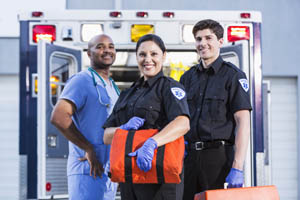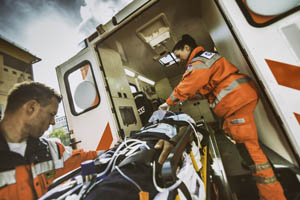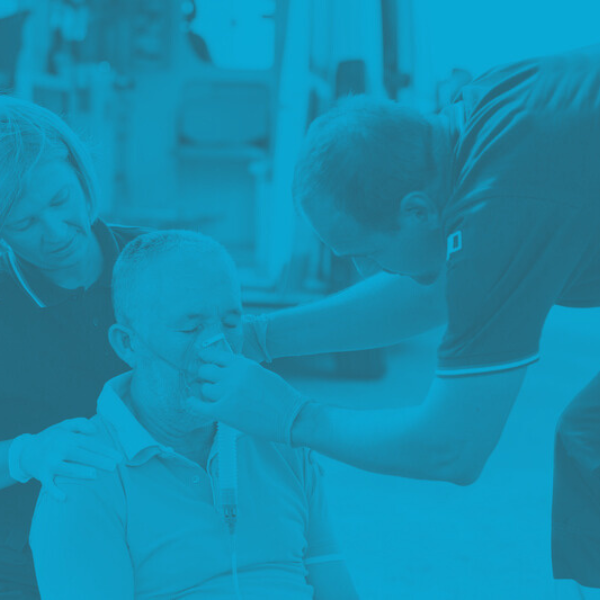EMT Training Options You Need to Know
EMT Training Options You Need to Know

by Greta Kviklyte
Life Saver, AMC
Co-authored by Kim Murray, RN, M.S.
posted on Feb 29, 2020, at 1:57 pm
From heart attack through injury, the chain of survival follows a common path. Recognize the emergency, activate emergency medical services (EMS), begin life-saving measures, obtain defibrillation for cardiac arrest, and begin basic and advanced emergency medical services, says CPR.Heart.Org. While it’s easy to focus on the value of chest compressions and first aid, as found in the course here, the biggest factor for out-of-hospital incident survival is obtaining EMS. Emergency medical technicians (EMTs) go through rigorous training to respond to the most high-stress of health care fields, working in people’s homes, stranger’s facilities, and everywhere in between to bring life-saving care to those that cannot make it to a hospital on their own.
We offer Online ACLS, PALS and BLS Certification and Renewal
Through EMT training, these remarkable individuals become lifesavers that go above and beyond daily, and the movement toward this career is expected to continue.
According to the U.S. Bureau of Labor Statistics (U.S. BLS), the demand for EMTs and Paramedics will increase 7% by 2028. Annual pay ranges from $22,760 to $58,640. The difference in wage reflects the culmination of EMTs across all levels, employment types, and experience. With demand expected to grow faster than the national average from all occupations, more students and health professionals will start considering their EMT training options and how to enter the fast-paced field.

To that end, those interested in moving to EMS should take the time to understand the various certification and licensing levels, how long EMT training may take, renewal requirements, and 10 tips to make training successful.
EMT Certification and License Vary by State
A big problem for prospective students interested in EMT training is deciding what course to take. No, this does not mean figuring out what institutions offer EMT training. Instead, it focuses on how far students wish to take their careers. While the National Registry of Emergency Medical Technicians (NREMT) maintains accreditation and records for all students that complete a program and pass examination, individual states have the authority to set different levels of EMT training and positions. The National EMS Scope of Practice Model, published by EMS.Gov, sets four specific levels for EMT training and employment that include:
- Emergency Medical Responder (EMR)
- EMT
- Advanced EMT
- Paramedic
A more robust description of each form of EMT training and occupation is as follows:
EMR
The EMR level is primarily a basic, initial assessment EMT. While this person does not necessarily have the title of EMT, he or she is responsible for initiating lifesaving care, including Cardiopulmonary Resuscitation (CPR) and Basic Life Support. These individuals work under the direction of an advanced medical professional, such as a Paramedic or Transport Nurse, and may use an AED, stabilize suspected cervical spine injuries, maintain bleeding control, and assist with emergency patient movement. High school students may also complete EMR training, and some schools, such as Jefferson High School, says the Marshall News Messenger, have taken the steps to offer basic and advanced EMT programs for students that can sit for the examination after turning age 18.
EMT
The EMT is a position that serves to provide basic emergency medical care and transportation for patients. The person must function as part of the comprehensive EMS response, comparable to an EMR. This position also includes the obtaining of vital signs, documenting a brief medical history, assisting patients with taking personal medications, administering oral glucose or aspirin, and applying a pneumatic anti-shock garment.
In some states, such as Texas, the levels are split into EMT-Basic, EMT-Intermediate, and EMT-Paramedic. For this reason, all three levels in Texas have the title of EMT. However, the EMT-Basic is most comparable to an EMR. Again, the differences in states may mean that a person with an EMT-Basic may work in EMR positions or as an EMT, depending on education and experience.
EMT Advanced
The advanced form of an EMT further complicates the levels. The EMT-Advanced is comparable to an EMT-Intermediate in Texas. The individual gains skills to bandage wounds, address serious medical emergencies, and may have the authority to administer medications in the presence of a higher-trained EMT. The type and variety of medications that an EMT-Intermediate or Advanced EMT may administer again varies by location. A few notable skills of an EMT Advanced level worker include establishing and maintaining IV access, administration of nitroglycerine, administering epinephrine, providing inhaled beta agonists, giving Narcan or administering nitrous oxide.
EMT Paramedic
The EMT Paramedic, or more simply Paramedic, is the most advanced form of an EMT. This allied health professional provides a comprehensive set of emergency medical care services, using both basic and advanced equipment. Paramedics may administer a wide variety of medications, start intravenous or intraosseous fluids, begin infusion of blood or blood products, and more. The Paramedic also commands the ambulance, so he or she carries the responsibility of making complex decisions and determining what to best care for each unique patient. Paramedics may also work on helicopters and planes to safely transport patients.
A Fifth Level: Pre-Hospital Nursing Courses Mirror EMT Training Programs
In addition to traditional EMT programs, some hospitals and health organizations have taken the initiative to train nurses, specifically RNs, to work in ambulances and provide added support. In such cases, the RN would take an EMT training course that would allow for working as a Transport Nurse. Furthermore, Transport Nurses may also work in flight capacities, explains EveryNurse, moving patients by plane, administering care under the direction of a physician, and covering paramedic staff shortages.
Other Levels Specific to an Individual Program or Course of Study
Individual counties and hospitals may also create added EMT-like programs to better serve community needs. While sources and statistics vary, dozens of different titles and meanings exist for these professionals across the country. They all tend to reflect one of the four primary levels of EMT training and work listed above.
Length of Time to Complete EMT Training
EMT training requirements also differ by level and state. The eligibility requirements for someone wishing to work as an EMR include completion of an accredited EMR training program. These programs may be as short or require up to eight weeks. Some areas may offer a short, one-day EMR training course that does offer minor EMT training, but it falls short of eligibility to work in the back of an ambulance. EMRs may also attain the designation of EMR prior to age 18, and the course takes approximately 12 hours to complete, depending on the program.
Obtaining a Basic EMT Certification requires approximately 150 hours of specialized instruction, says the U.S. BLS. Advanced EMT training requires approximately 400 hours of instruction. Paramedics have the longest duration of EMT training—around 1,200 hours. However, those that pursue a Paramedic Certification may also quickly qualify for an Associate’s or Bachelor’s degree.
It is important to note that while the courses generally include all necessary classwork to obtain the respective certifications, some programs may require students pursuing an Advanced EMT training program or higher complete prerequisite classes at an approved educational institution. For example, students interested in becoming a Paramedic may need to complete an Anatomy and Physiology course prior to enrollment. To avoid delays, interested students should review pre-requisite requirements prior to enrolling in any program.
10 Tips for Learning the Most From Clinical Ride-Alongs
 Since EMT training includes clinical ride-alongs in ambulances and in-hospital, hands-on experience, it helps to have a few tricks to maximize learning experiences and keep track of new skills.
Since EMT training includes clinical ride-alongs in ambulances and in-hospital, hands-on experience, it helps to have a few tricks to maximize learning experiences and keep track of new skills.
1. Get Plenty of Sleep
The first tip might seem unhelpful. But, getting enough sleep is essential. Unlike classroom work, the clinical setting is an active environment, and tired students could make mistakes that cause poor health outcomes for patients. Regardless of what is happening in the social realm, ensure you get a full night’s rest before going on any clinical trips.
2. Complete all Required Applications, Focusing on Why You Want to Enter EMT Training
The next step is completion of the physical application for the program. Since the EMT training program is an evolving career, it may be necessary to reapply for subsequent semesters or training sessions. It depends on the specified policies per institution. When completing any application, always stay forward-thinking and answer any questions fully and to the best of your ability. Since the field of EMTs is expected to grow, more programs are following competitive entry processes, requiring students to pass strict tests and complete essay-like questions. So, take the time to brush up on your grammar and spellling along the way. To help that point, there are four hidden errors in this tips’ section. Can you find them in three minutes or less? If not, it’s time to review your writing skills.
3. Review Course Materials Daily
Review all course materials assigned prior to attending clinicals. If you are uncertain what the next topic will be, consider reviewing your outlined notes and pysiology books as added preparation. Also, reviewing medication abbreviations will go a long way in building your skills.
4. Keep a Small Notepad on Hand
A small notepad is a great tool for taking notes. While your phone might have numerous note-taking apps and resources, using your phone in the clinical setting may spread pathogens and contribute to poor patient outcomes. Also, avoid taking notes when wearing gloves.
5. Write Down Top Learning Notes at the End of Each Day
At the end of each day write down a list of the top things learned from that experience. This list can be ongoing within your notepad, or it may also be a review of your primary experiences. It is up to you to decide what to write. Just remember to avoid mentioning any patient information that is protected under HIPAA in it.
6. Focus on the Needs of the Patient and How to Best Address the Problem
The next tip is to think like an EMT. This means looking to the patient to figure out the most severe problem and how to best address the situation. Do not worry; the Paramedic or other instructor will be in charge. The challenge is for you to determine what the next best step will be and how it will help the patient survive.
7. Apply Skills Per the Clinical Instructor
During clinicals, hands-on instruction can be overwhelming. Try to overcome your fears of working with patients by applying your skills. If some thing does not make sense, ask.
8. Stay Open to Learning New Skills
Keeping your mind open to new experiences during clinicals will teach you more in a day than you can imagine. In the EMT field, new experiences can range from car accidents through people experiencing mental health crises. In fact, consider reviewing other materials, such as Mental Health First Aide, noted here, to help prepare for the unexpected.
9. Join or Create a Peer Study Group for Discussing Different Experiences and Skills
Unlike in-hospital clinicals, the experiences in the back of an ambulance are always changing and moving. The experiences you have may not be the same as your peers. Consider joining or creating a study group to discuss experiences and learn as a team. This tip also has the benefit of teaching students to work together—a critical skill for EMTs and all health professionals alike.
10. Get Your CPR and BLS
Taking the step to obtain your CPR and BLS Certification prior to enrolling in EMT training demonstrates your willingness to stay prepared and be ready to respond. Remember that EMTs are driven by response, so any pre-emptive measure in school will lend itself to better preparedness in the ambulance and other clinical settings. More importantly, EMT training programs may require all applicants to complete basic CPR and BLS courses before applying. However, some EMT-Basic programs may also include CPR and BLS initial training as part of the course. It all depends on the course provider.
Become a Lifesaver; Start Thinking About EMT Training for Your Next Career Move
EMT training is a great way to give back to the community and become a more focused professional. EMTs deal with a variety of circumstances and literally save lives. While EMT training requirements vary by level and state, the career opportunities are significant. It is a fast-growing, well-paying aspect of the health industry, and by learning more about the field, you can be better prepared to succeed and save lives as well.
Have you thought about becoming an EMT? If so, share why you want to enter the excitement of pre-hospital care, as well as this article, to social media now. Also, take the next step by enrolling in your life-saving skills course, such as the one available here, today.




I didn’t know that EMT levels varied per state, that explains why my friend from a different state who knows about this stuff contradicts the things I researched on my own. It’s really helpful to know the different EMT positions that there are so that I can really find out and specialize on what I want to become once I enter an EMT program. I still have to research on the exact ways my state handles things though so that way I can have a much better idea on what I want when I get there.
Thanks for the comment Tammie! Glad you found the article useful. If you are interested in looking into it further, you may want to check out the National Registry for Emergency Medical Technicians (NREMT) website for any specific questions, as they are the governing body for all EMT licenses. And in the meantime, our classes are a great way to get a feel for the material and a headstart on learning how to save lives 🙂 Let us know if you have any questions!